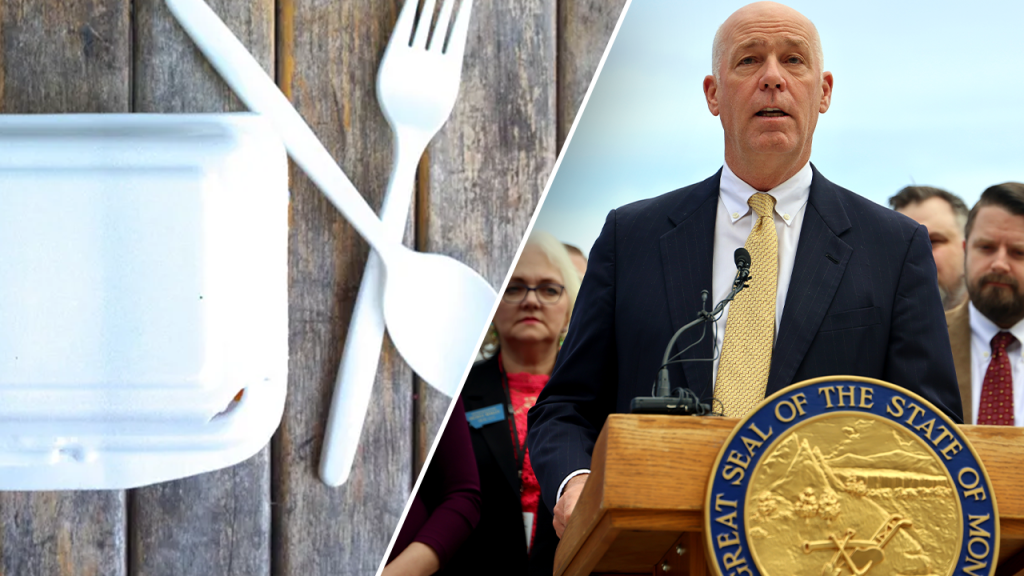Montana Governor Greg Gianforte has vetoed a significant legislative proposal aimed at phasing out Styrofoam containers statewide, citing the decision as an example of “textbook government overreach.” The rejected House Bill 477, initially introduced by Democrat state representative Marilyn Marler, aimed to ban Styrofoam from use by restaurants and the hospitality sector by 2028, with a complete elimination by 2030. The bill received backing from some bipartisan voices within the predominantly Republican legislature, highlighting a complex debate over environmental policy and industry regulation in Montana.
| Article Subheadings |
|---|
| 1) Governor’s Overview of the Veto Decision |
| 2) Legislative Intent and Environmental Concerns |
| 3) Economic Ramifications of the Ban |
| 4) Public Response and Industry Perspectives |
| 5) Future Implications for Environmental Policies |
Governor’s Overview of the Veto Decision
Governor Greg Gianforte articulated his reasons for vetoing House Bill 477 in a strongly worded letter. He characterized the ban as an unnecessary interference by the government in business operations, arguing that “our state should remain a sanctuary for freedom and free enterprise.” The governor also expressed concern about Montana adopting regulations seen in other states, especially those he referred to as “deep blue” where similar laws have already been enacted. He labeled the bill as overly prescriptive, asserting that it dictated which materials restaurants and food establishments could use, thereby infringing on their autonomy.
Legislative Intent and Environmental Concerns
The intent behind House Bill 477, as noted by Marilyn Marler, was primarily driven by environmental concerns and public health considerations. The legislation highlighted the detrimental impact of Styrofoam, specifically how it poses a threat to marine and wildlife, fills landfills, and potentially undermines the rights of Montanans to a clean environment. Proponents of the bill observed that many restaurants and businesses have already moved towards more sustainable options. The lawmakers pushed for regulatory action to align Montana with a growing national trend against single-use plastics and Styrofoam, believing that addressing these environmental issues is a crucial step for the future of the state.
Economic Ramifications of the Ban
In his veto, Governor Gianforte raised concerns about the potential economic burden the ban could place on businesses. He estimated that additional costs would arise from compliance with a new Montana Department of Environmental Quality program, totaling approximately $300,000, which would ultimately be borne by taxpayers. Furthermore, he opined that additional adjustments would likely be necessary for businesses transitioning away from Styrofoam, potentially leading to greater costs for consumers. This concern further fueled his argument against the regulation, emphasizing the balance between public health initiatives and maintaining a favorable business environment.
Public Response and Industry Perspectives
The decision to veto House Bill 477 has drawn a mixed reaction from the public and industry stakeholders. While environmental groups and advocates for sustainable practices criticized the governor’s decision, arguing that it dismisses critical environmental concerns, local business owners expressed relief, citing potential operational challenges posed by the transition away from Styrofoam products. Many in the restaurant and food service industries fear that adopting new packaging solutions would require significant retraining and a restructuring of supply chains. The debate around the veto has therefore highlighted a broader public discourse on balancing environmental responsibility with businesses’ practical needs.
Future Implications for Environmental Policies
The fallout from the veto of House Bill 477 could set a precedent for future legislative efforts to regulate materials linked to environmental degradation. As states across the country navigate the complex interplay between economic interests and environmental stewardship, Montana’s decision may influence how other states approach similar issues. The governor’s clear stance might encourage other officials in conservative states to reject or resist similar environmental legislation, creating a fragmented approach to national environmental challenges. Conversely, proponents of environmental regulations may continue to advocate for change, seeking more creative or alternative pathways to encourage sustainability within the state.
| No. | Key Points |
|---|---|
| 1 | Governor Gianforte vetoed House Bill 477, claiming it is government overreach. |
| 2 | The bill sought to phase out Styrofoam containers in the food service industry by 2030. |
| 3 | Concerns regarding the economic impact of replacing Styrofoam were central to the governor’s decision. |
| 4 | Supporters argued the bill was necessary for environmental protection and public health. |
| 5 | The veto decision may influence future environmental legislation in conservative states. |
Summary
The veto of House Bill 477 by Governor Greg Gianforte showcases the challenges faced by state lawmakers in addressing environmental concerns while balancing business interests. This decision indicates a significant ideological divide, reflecting broader national conversations about sustainability, economic growth, and the role of government regulation. By rejecting legislation aimed at reducing the reliance on Styrofoam, Montana continues to grapple with complex environmental issues amidst varied public and industry expectations.
Frequently Asked Questions
Question: Why was House Bill 477 introduced?
House Bill 477 was introduced in response to rising concerns about the environmental and health impacts of Styrofoam containers, pushing for a gradual phase-out to align with sustainable practices.
Question: What are the main arguments against the Styrofoam ban?
Opponents, including Governor Gianforte, argue that the ban represents governmental overreach, could impose significant costs on businesses, and may disrupt the operational autonomy of numerous food service establishments.
Question: How do environmental advocates view the veto?
Environmental advocates have criticized the veto, asserting it undermines efforts to protect natural resources and public health, and they continue to push for measures aimed at reducing plastic waste.


